Chile, a land of contrasts and wonders, stretches from the driest desert on Earth to the icy beauty of glacier fields. This long, slender country on South America’s western edge promises adventure and discovery at every turn.
Whether it’s the allure of the Andes, the mysteries of Easter Island, or the vibrant culture of its cities, Chile offers a unique experience for every traveller.
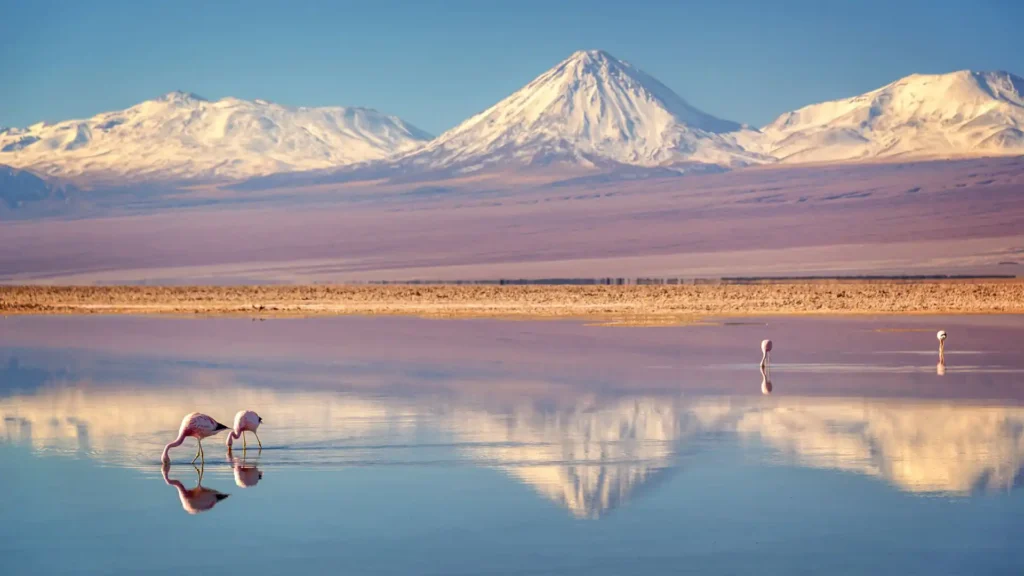
The Atacama Desert, known as the driest place on Earth, offers more than just arid landscapes. In San Pedro de Atacama, a small town serving as a gateway to this lunar-like desert, you find a world that seems almost out of this planet. The Valle de la Luna, or Valley of the Moon, is a must-visit spot.
Here, the jagged, salt-laden landscapes and dunes provide an ethereal experience, especially at sunset when the sky’s colours transform the view into something magical.
Star-gazing in the Atacama is an experience like no other. The clear, unpolluted skies reveal a canvas of stars, planets, and galaxies, making it one of the best places in the world for astronomy.
Numerous observatories offer night tours, where experts guide you through the celestial wonders. The Milky Way stretches across the sky so vividly, it feels like you could reach out and touch it.
Adventurous souls can indulge in activities like sandboarding on the desert’s dunes or visiting the geothermal field of El Tatio to witness geysers shooting steam into the cool morning air. These natural hot springs are a welcome respite in the chilly desert mornings.
The contrast of the rising sun, the steam from the geysers, and the rugged backdrop of the Andes creates a memorable spectacle.
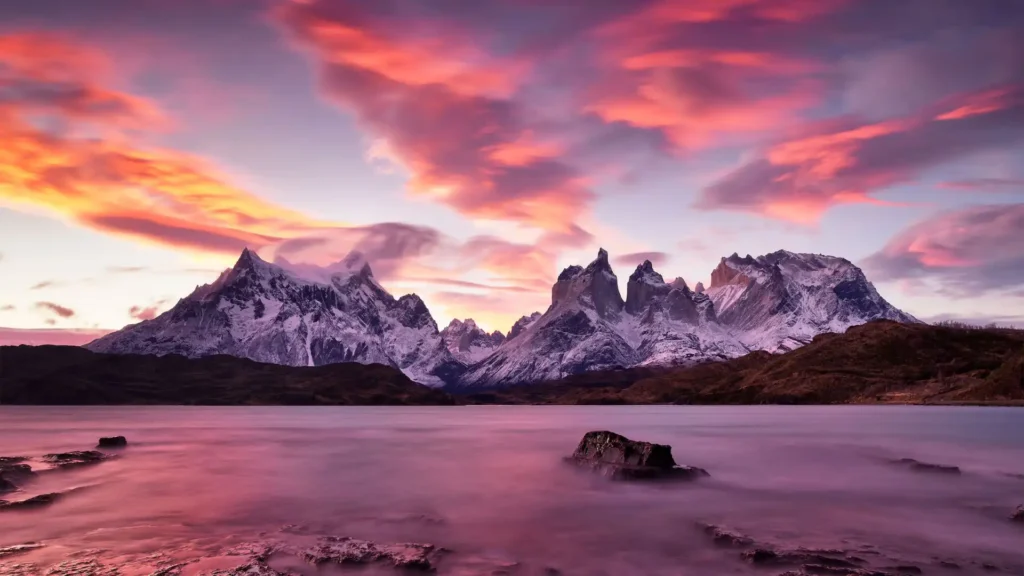
Torres del Paine National Park in Chilean Patagonia is a place where nature’s grandeur is on full display. The park is famed for its towering granite peaks, the Paine Massif, which dominate the landscape.
These iconic towers draw hikers and nature lovers from around the world, offering challenging treks and breathtaking views. The park’s trails wind through diverse terrains, from vast grasslands to dense forests, alongside glaciers, rivers, and azure lakes.
Wildlife in Torres del Paine is as diverse as its landscapes. Guanacos roam freely, and with some luck, you might spot Andean condors soaring above or even the elusive puma. The park’s flora and fauna are adapted to the harsh Patagonian climate, offering a glimpse into the resilience of nature. Every turn on the trail presents a new, awe-inspiring vista, ensuring that your journey through Torres del Paine remains etched in your memory.
For those who prefer a less strenuous experience, boat tours provide a serene way to appreciate the beauty of the park. These tours often venture close to massive glaciers, where the sound of ice calving is a powerful reminder of nature’s ongoing sculpting of the landscape.
Whether it’s through trekking, photography, or simply soaking in the views, Torres del Paine is a testament to the wild, unspoiled beauty of Patagonia.
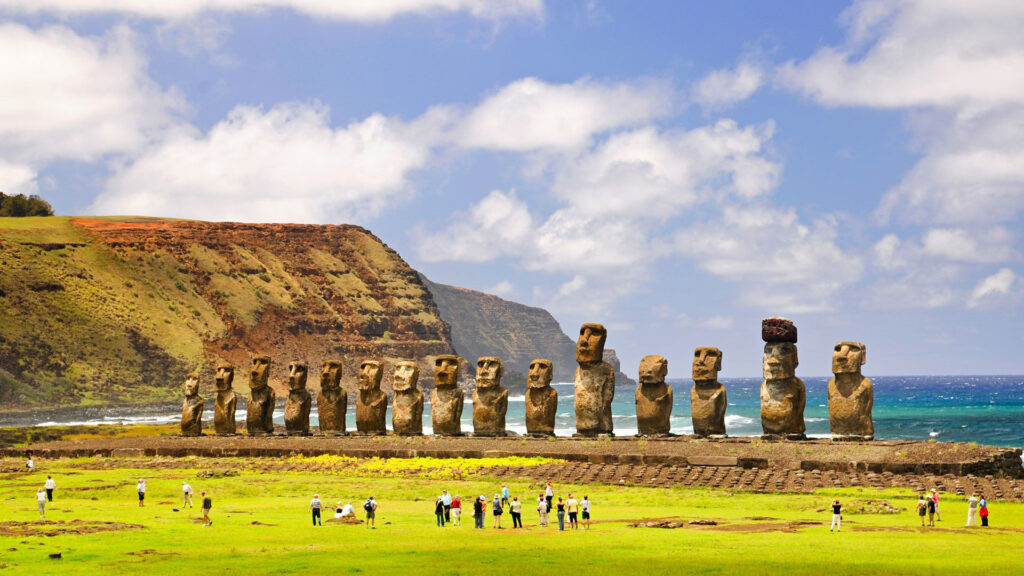
Easter Island, or Rapa Nui, is a speck in the Pacific Ocean that holds one of the world’s most enduring mysteries. The Moai statues, giant stone figures carved by the island’s early inhabitants, stand guard across the island, their origins and purpose shrouded in mystery.
These impressive statues, some towering over 10 meters tall and weighing several tons, are a testament to the ingenuity and creativity of the ancient Rapanui people.
The island is not just about the Moai, though. It’s a place of rugged natural beauty, with volcanic craters, lava formations, and beautiful beaches. Anakena Beach, with its white coral sand and swaying palm trees, offers a tropical respite. It’s one of the few sandy beaches on the island and a perfect spot for relaxation after exploring the archaeological sites.
Delving into the island’s history, visitors can explore the ceremonial village of Orongo, perched on the edge of a crater lake. This site is known for the Birdman cult, where competitors once vied to collect the first sooty tern egg of the season from a nearby islet.
The cultural richness of Easter Island extends beyond its physical monuments, as the local Rapanui people keep their traditions alive through music, dance, and storytelling.
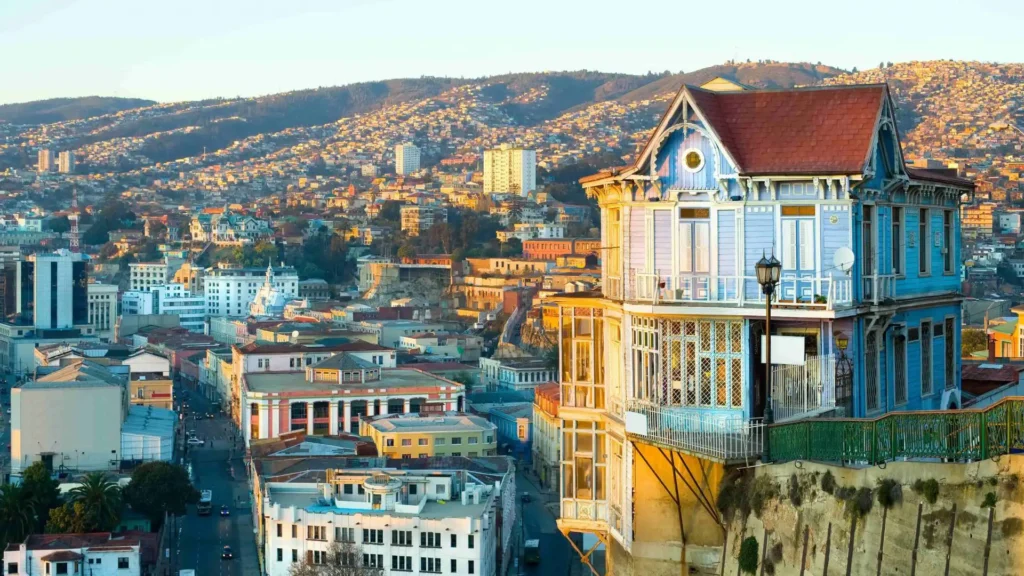
Valparaiso, a port city on Chile’s coast, is a burst of colour and creativity. The city’s hills are adorned with brightly painted houses, and the streets are a canvas for some of South America’s best street art.
This bohemian vibe is palpable as you wander through its narrow, winding streets, staircases, and alleys. Each corner reveals a new mural or graffiti piece, telling stories of the city’s culture and history.
The city’s most famous resident, Nobel Prize-winning poet Pablo Neruda, left his mark here. His house, La Sebastiana, now a museum, offers a glimpse into his life and affords panoramic views of the city and the Pacific Ocean.
Neruda’s love for Valparaiso is evident in his collections and the design of the house, reflecting his quirky and artistic personality.
Exploring Valparaiso also involves riding its historic funicular elevators. These elevators, some over a hundred years old, were built to connect the lower city with the hilltop neighbourhoods.
Riding them offers not just convenience but also a step back in time. The views from the top are spectacular, encompassing the bustling port, the endless ocean, and the colourful tapestry of buildings.
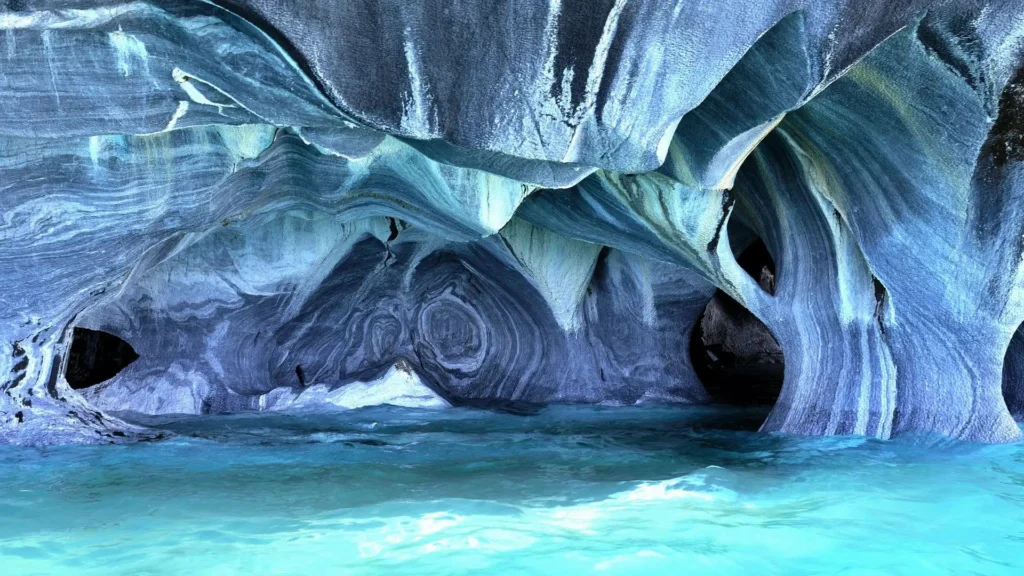
The Marble Caves, located on General Carrera Lake in Chilean Patagonia, are a natural wonder unlike any other. These caves are formed from marble and have been sculpted by the lake’s azure waters over thousands of years.
The result is a series of caverns, tunnels, and pillars in varying shades of blue and grey, creating a surreal and otherworldly landscape.
Boat tours are the best way to explore the Marble Caves. As you glide through the smooth waters of the lake, the sunlight plays off the cave walls, casting reflections and illuminating the intricate patterns in the marble.
The experience is both tranquil and awe-inspiring, as each turn brings a new formation or colour palette into view.
The Marble Caves are not only a visual spectacle but also a geological marvel. The changing water levels of the lake, influenced by glacial melt and seasonal rainfall, continually reshape the caves.
This dynamic environment means that each visit can offer a slightly different experience, with new angles and perspectives revealed.
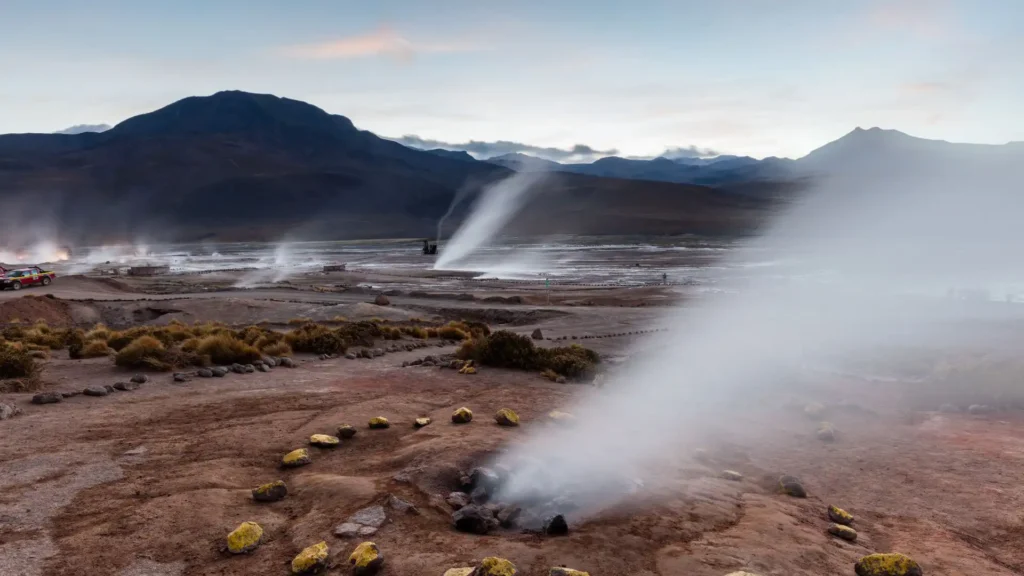
El Tatio, a geyser field near San Pedro de Atacama, greets the early morning with a show of steam and geothermal activity. As one of the highest geyser fields in the world, it sits at over 4,300 meters above sea level. The sight of dozens of geysers releasing steam into the cold morning air is both eerie and mesmerising.
Visiting El Tatio is an exercise in timing and preparation. The geysers are most active at dawn, so tours often start in the early hours.
The temperature can be freezing, but the sight of the sun rising over the steam-filled landscape is worth the early start. As the day warms, the steam slowly dissipates, revealing bubbling pools and fumaroles.
Safety is paramount in El Tatio. The area around the geysers can be unstable, and the water is scalding hot.
Guided tours ensure a safe experience, with knowledgeable guides explaining the geothermal phenomena and leading visitors to the best viewing spots. Beyond the geysers, the area is home to unique flora and fauna, including vicuñas and viscachas, adapted to the harsh high-altitude environment.
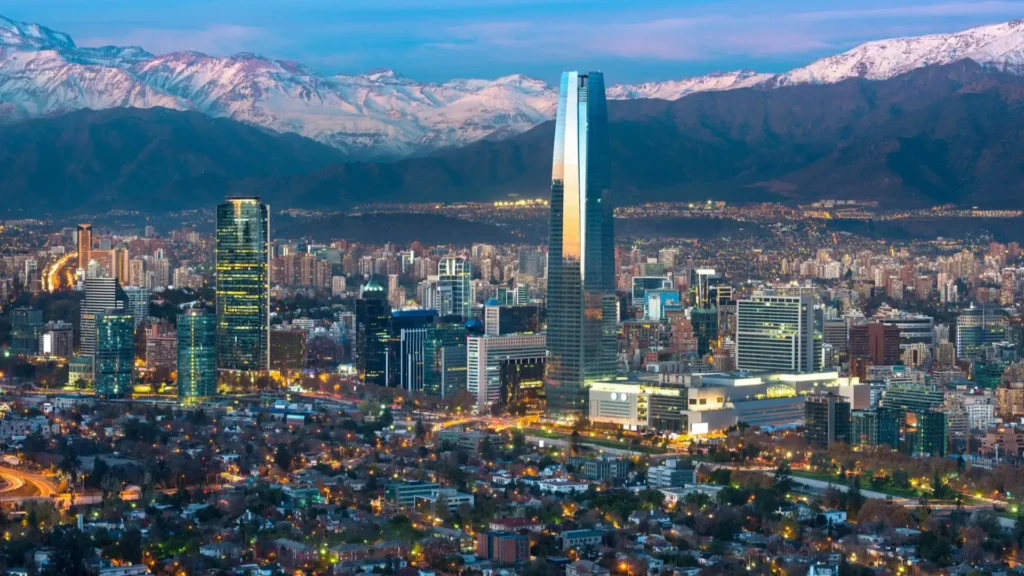
Santiago, the capital of Chile, is a city where tradition meets modernity. Nestled in the Central Valley, with the Andes Mountains as a backdrop, the city offers a mix of cultural and historical experiences. At its heart is the Plaza de Armas, the founding point of Santiago.
This historic square is surrounded by important buildings like the Metropolitan Cathedral and the Central Post Office.
Exploring Santiago’s diverse neighbourhoods reveals the city’s many faces. Bellavista is known for its vibrant nightlife and artistic flair, while Lastarria attracts with its stylish cafes, boutiques, and street performers. For a taste of local life, a visit to La Vega Central market is a must.
This bustling market is a sensory overload, with vendors selling everything from fresh produce to local crafts.
The city’s parks and green spaces offer a respite from the urban bustle. Cerro San Cristóbal, part of the larger Metropolitan Park, provides panoramic views of the city and the mountains.
The ascent can be made by foot, bicycle, or the funicular railway. At the top, besides the views, stands a large statue of the Virgin Mary, watching over Santiago.
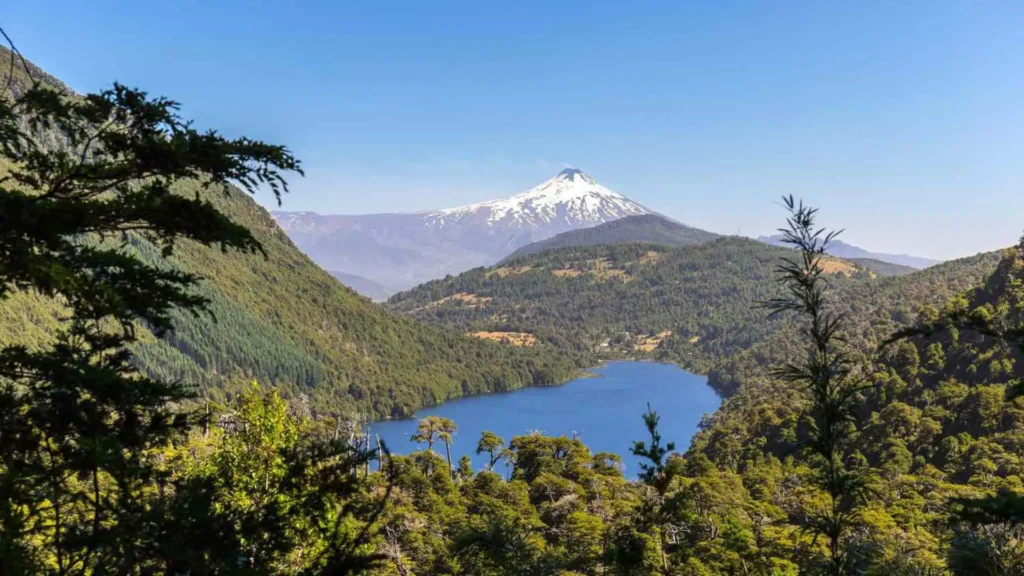
The Chilean Lake District, in the southern part of the country, is a realm of natural splendour. Here, crystal-clear lakes mirror the sky, and snow-capped volcanoes stand guard. The region is a haven for outdoor enthusiasts, with opportunities for hiking, kayaking, and fishing in a serene setting.
The town of Puerto Varas, known as the “City of Roses,” is a charming base for exploring the region. Overlooking Lake Llanquihue, Chile’s second-largest lake, and the Osorno Volcano
Puerto Varas encapsulates the beauty of the Lake District. The town’s German heritage is evident in its architecture and culinary offerings, adding a unique cultural layer to the visit.
Hiking in the Lake District is a journey through diverse landscapes. Trails lead through ancient forests, along the shores of lakes, and up volcanic slopes offering stunning vistas.
One of the most popular hikes is in the Vicente Pérez Rosales National Park, leading to the Petrohué Waterfalls. These falls, set against a backdrop of volcanoes and lush greenery, are a powerful display of nature’s force.
Kayaking on the region’s lakes offers a different perspective. Gliding over the water, you’re surrounded by tranquillity, with only the sound of your paddle and the occasional call of a bird.
The lakes are dotted with small islands and hidden coves, perfect for exploration. For those who prefer a more relaxed experience, scenic boat tours are available, allowing you to soak in the scenery without the exertion.
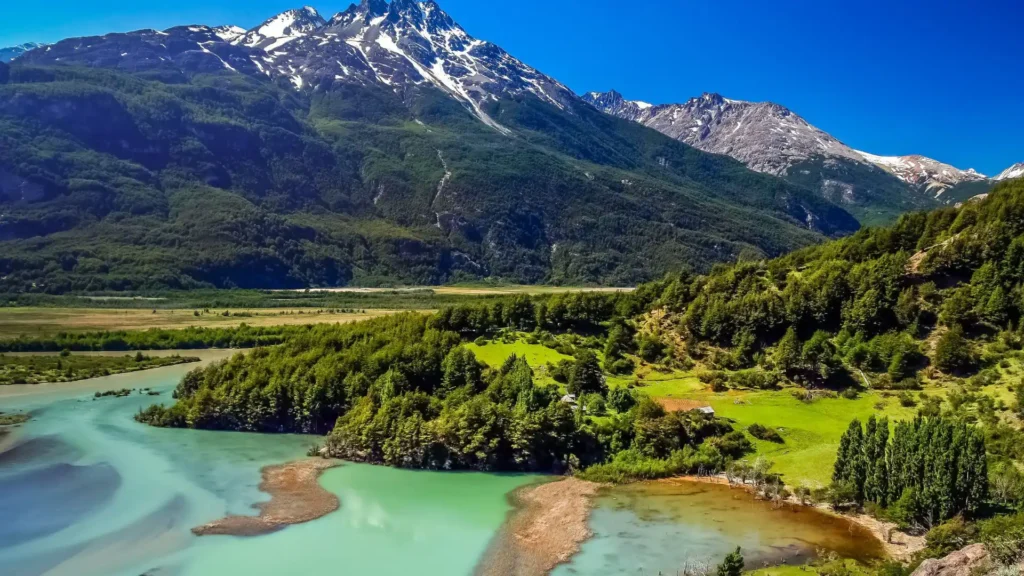
Pumalín Park, in Northern Patagonia, is a vast expanse of wilderness dedicated to conservation and nature. Created by an American philanthropist, this park is a testament to the importance of preserving natural habitats.
Its landscapes range from dense temperate rainforests to rugged coastline, each area teeming with biodiversity.
Hiking in Pumalín Park is an exploration of unspoiled nature. Trails lead through ancient forests where the trees are centuries old, their canopies forming a green roof overhead.
The air is fresh and filled with the sounds of nature, from the rustling of leaves to the distant calls of birds. Each trail offers a unique view of the park’s diverse ecosystems, whether it’s a secluded beach or a viewpoint overlooking a fjord.
One of the highlights of Pumalín Park is the Douglas Tompkins Visitor Centre, which provides insight into the park’s history and conservation efforts.
The centre is a tribute to Tompkins’ vision and commitment to environmental preservation. Visitors can learn about the park’s flora and fauna, as well as the ongoing efforts to maintain this pristine wilderness.
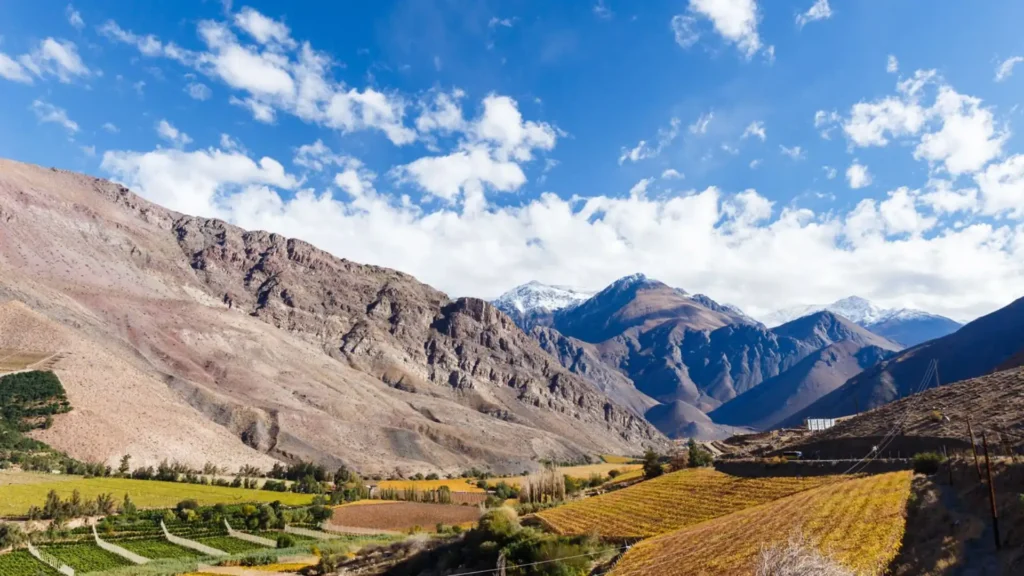
La Serena, one of Chile’s oldest cities, offers a blend of beautiful beaches and historic architecture.
The city’s colonial past is evident in its churches and buildings, with narrow streets leading to hidden plazas and gardens. La Serena’s lighthouse, Faro de La Serena, is a landmark and a popular spot for panoramic views of the city and the sea.
Just a short drive from La Serena lies the Elqui Valley, an area famous for its clear skies and astronomical observatories.
The valley is one of the best places in the world for stargazing, thanks to its high altitude and minimal light pollution. Visitors can join nighttime tours at observatories like Cerro Mamalluca, where powerful telescopes offer a glimpse into the cosmos.
The Elqui Valley is also known for its pisco, a grape brandy that is a staple of Chilean and Peruvian cuisine. Pisco distilleries dot the valley, and many offer tours and tastings. The valley’s sunny climate is perfect for growing the grapes used in pisco production, and the distilleries are proud to share their craft with visitors.